Andrea Downing's Blog, page 16
November 27, 2012
MEMORIES OF A WESTERN CHRISTMAS
PLEASE SEE BELOW FOR OUR BIG CHRISTMAS GIVEAWAY!
Christmas to me has always meant a beach. Yes, you read that correctly: a beach. My grandmother was one of 11 children and by the time I was of school age, the surviving siblings had all moved to Florida to escape New York winters. This meant that, in order to be together for the holiday season, our immediate family was piled into a car for the three day drive from NY to Florida—the beach.
There were things that did compensate slightly for this wrench from the possibility of a white Christmas. While I was appalled at the sight of plastic reindeer under the palm trees, I came to count the days until I could eat my way through a box of coconut patties, indulge in the sheer enjoyment of slipping one from its individual pocket wrapping and savoring the dark chocolate covering over creamy sweet coconut. There was the spurt of juice from a fresh orange as we plunged little plastic spouts through the skin and sucked out the fluid. And there was drifting to sleep to the quiet chatter of the elderly, punctuated by the creak of rocking chairs on the porch, before the mosquitoes sent the folks inside. But this was not my dream Christmas. My dream Christmas was in snow-covered hills amidst pines with horses waiting outside to take you for a sleigh ride, the Rocky Mts. as back drop—what I envisaged as a western Christmas. About as close to ‘western’ as my Christmas went was buying carved coconut heads from the Seminole Indians.
I know now that there is no typical ‘Holiday Season.’ Whether you celebrate Christmas or Chanukah or nothing at all, the sheer joy of being with family and friends is what counts the most. I’m delighted to be sharing my blog this month with 5 fellow authors who have their own Christmas memories—the kind of western ones that I daydreamed about all those years ago.
* * *
Award winning author Paty Jager grew up on a rural ranch in NE Oregon and now raises hay and cattle on 350 acres with her husband of thirty-three years. Always having a story in her head proved valuable—she now has fifteen published novels.
Snowshoe Christmas
My most vivid memory happened on my twelfth Christmas. My family lived on a 200 acre ranch up a canyon of the Wallowa Mountains. When I say my family, it means my mom and dad, my dad’s parents, my two brothers, and me. Seven of us lived in an 1800’s two story farm house with a wood stove for heat and cooking and an outhouse we used when the pipes froze up.
It happened this particular year that only my dad and I were immune to a nasty flu that was going around right before Christmas. This December also happened to have one of our biggest snowfalls. It was the week before Christmas and my mom insisted we needed the Christmas tree. She didn’t trust my dad to not go out and chop down the first one he came to, so being the only other well person, I was sent out with Dad to get our tree.
Because of the huge snowfall, we only made it up the county road about a mile in the old International Scout before we had to stop and put on our snowshoes. This was my first excursion into the wild on the shoes. My brothers and I had played with them around the yard but walking out in the forest I learned there are pitfalls you can’t see.
Dad warned me not to go near the trees and stay away from bumps in the snow.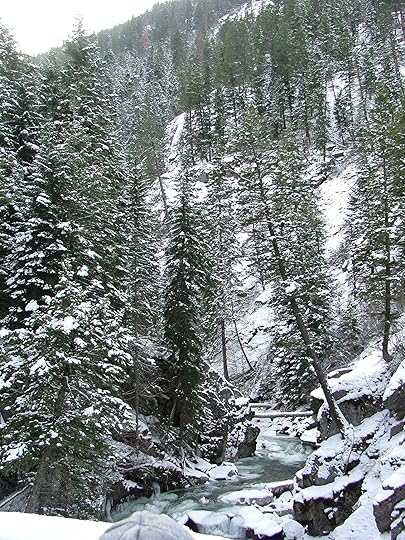 Walking up to one tree to shake the snow loose to look at it, I ventured too close and found myself four feet lower than my dad. I’d fallen into a hole made by the branches of the tree catching the snow. Dad grabbed me by the back of my coat and pulled me out of the hole, once again reciting to stay away from trees.
Walking up to one tree to shake the snow loose to look at it, I ventured too close and found myself four feet lower than my dad. I’d fallen into a hole made by the branches of the tree catching the snow. Dad grabbed me by the back of my coat and pulled me out of the hole, once again reciting to stay away from trees.
We found what I thought would be a good tree. As I walked around the tree, my eyes on the shiny green needles, the ground fell out from under me. I landed with my bottom on a bush and my snowshoes, arms, and head pointed to the opening above me. I was cradled in the snow and a bush. I looked up. Dad peered into the hole, laughing. When he caught his breath, he reached in and pulled me out.
The tree was cut and dragged to the scout with me only falling in a hole one more time. At home, Mom deemed the tree the best ever and as the decorating began Dad told everyone how many times he had to pull me out of the snow. To this day when getting a Christmas tree is mentioned, he reminds everyone how many times I fell through the snow and he had to save me.
Gambling on an Angel ‘The only thing Bas Slocum cares about is his saloon—until he meets an angel wearing a Temperance ribbon.’ Available on Kindle, Nook , and Smashwords
http://www.patyjager.blogspot.com http://www.patyjager.net
* * *
Karen Casey Fitzjerrell grew up on a small ranch outside an equally small community in South Central Texas. Karen’s writing history includes freelancing for Texas newspapers, namely the Houston Chronicle, and regional magazines from 1997 to 2002. The Dividing Season, her first novel, is a finalist for the 2013 EPIC E-book Award, winner to be announced in March.
Whose Christmas Tree Is It?
Christmas 1955, my mother drove my brothers, sisters and me into town to buy a Christmas tree. We were ecstatic, scurried up and down the rows of trees like a bunch of rabbits until mother announced all them were too expensive. We begged her to reconsider, but it didn’t help.
Back home, we repeated our spiel to Dad at the back steps where he sat gulping coffee. He told mother to load us back up, that we were going to get a Christmas tree.
Joy once again.
Daddy gunned his old Buick onto the highway and explained that we were going to the deep piney woods behind Uncle Bill’s house. There, we could pick out any tree we wanted and it wouldn’t cost a thing except his sweat in chopping it down.
I don’t think Daddy ever thought about the possibility that each one of his five offspring would pick a tree of their own choosing. I found a tree that was small enough I could put a star on top all by myself. My older sister wanted a tree that had more branches than mine. The youngest bawled because he didn’t understand all the fuss. The other two went in together hoping that numbers would count.
Patient as could be, Dad asked each one of us to stand next to the tree we thought was best. He circled each one without uttering a word. Curiosity was about to choke us kids. What was he doing and why? Finally, he called us to “assembly.”
He said, “Go on back to the car and wait with your mother.”
“But—” He shushed us, and said, “Get.”
We tromped back through the tangle of pine forest and sat on the bumper of the car in cool damp December air while mother practiced her harmonica music and dreamed of fame. Before long Daddy came lumbering out of the woods with the most beautiful Christmas tree ever slung over his shoulder.
He never told us which of our trees he cut down or if he picked out one himself. Typical of children, we each tried to claim it was ours. In truth, it didn’t matter a bit. The Christmas tree was perfect.
In The Dividing Season, Karen Casey Fitzjerrell celebrates the redemptive qualities of the human spirit and raises the question: What are you willing to give up in order to calm those secret longings that beg for something more? Available at any book store or at Barnes and Noble and Amazon.
http://www.karencaseyfitzjerrell.com www.karencaseyfitzjerrell.blogspot.com
* * *
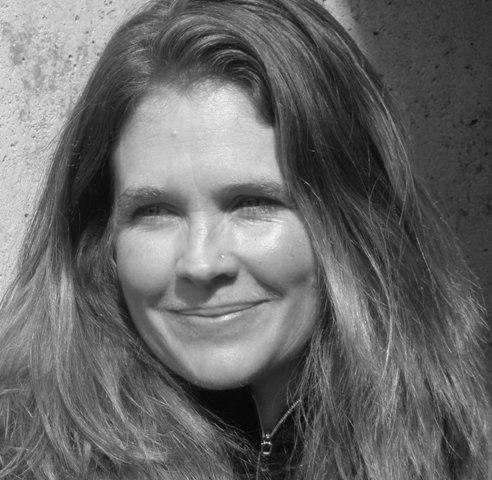 Amy Hale Auker is a Texan now living in Arizona, a writer, mother, and cowboy. Her first book Rightful Place is the 2012 WILLA winner for creative non-fiction and Foreword Book Reviews’ Book of the Year for essays. She’s never spent an eastern Christmas.
Amy Hale Auker is a Texan now living in Arizona, a writer, mother, and cowboy. Her first book Rightful Place is the 2012 WILLA winner for creative non-fiction and Foreword Book Reviews’ Book of the Year for essays. She’s never spent an eastern Christmas.
I have been pondering the idea of a western Christmas as opposed to… well, I suppose, an eastern one.
I married a working ranch cowboy when I was 19 years old and in the process, also married myself to a cowboy paycheck, a very limited budget in normal months, impossible with two small children at Christmas. The first year I got what I asked for..a set of cast iron skillets that he didn’t hide very well on our eighty mile journey home from Wal-mart. That’s pretty western.
For many years that cowboy cut us a cedar tree from the pasture, and we soaked it in the water trough overnight to rid its branches of ticks. During those years our celebrations were subject to true births..two-year-old heifers standing heavy with calf in the lot.
In Christmases past, I scattered cheap decorations in every corner of the house, went to several pointless parties, overdosed on insipid music, and cried with frustration into my pillow.
On Christmas Eves of the past I was exhausted, flour-covered, pale, hair-tangled, and footsore.
But one thing we can count on in life is change–no matter where you live. My nest is empty now; I am no longer 19. I cowboy for a living instead of cooking for cowboys, washing up after cowboys, listening to cowboy stories. On this ranch, the cows graze the forest and we hope for gentle storms. The heifers give birth among their own and we see them in the spring.
In Christmases past, the winter solstice passed me by. This year I will stand at attention as the night closes in early, as the dark grabs the stage, as coffee and woodsmoke and cold wind and happy wrap up the year with a frigid morning, saying, “Spring WILL come again.”
Rightful Place — words that spring from a deep intimacy with the land. Available here. www.amyhaleauker.com
* * *
Growing up out West, Rionna Morgan followed her love of horses to the rodeo arena and her love of English to the classroom and to writing. She loves most of all combining the chilling edge of a knife with the sweet surrender of romance. Rionna shares her home in Missoula, Montana with her husband, her four children and the mountains outside her window.
Tumbleweed Christmas
I grew up in the shadow of the Rocky Mountains. The very small shadow at the edge of the prairie. On the plains of Colorado, I learned to love to ride my horse. I learned to dance the two-step to a slow George Strait song, and I learned that the best gifts in life last forever.
When I was eight years old, my dad left Colorado and the fears and demons of the Vietnam War went with him. In those days, I had no idea what PTSD was. All I knew is that my mom cried the day he left and never again after.
I was kid. I was a little freckled faced girl with curly long red hair and a Morgan horse named Molly Jane for a best friend. We talked all the time, her and I. When December came and the first flakes of snow began to fall on the wide expanse of prairie, we started wondering about Christmas and Santa Claus. What were we going to do for presents?
I decided to write a few poems and hide them around the house for my four brothers and two sisters…and my mom.
My mom came home Christmas Eve with a huge tumbleweed and a can of spray paint. All of us stood on the porch, near the cistern and watched and laughed as she painted that weed a beautiful silver. We put it in our living room and decorated it with popcorn and cranberry ropes. We sang songs, all the Christmas songs we knew and went to bed knowing that Santa would bring us beautiful things while we dreamed away the night.
In the morning, sure enough, the house smelled like a cinnamon, chocolate heaven. Our tumbleweed had presents, shiny red and green packages, bulging from beneath its branches. My mom, who worked every day, every holiday as a nurse in town, stood singing “Oh, Christmas Tree” as she stirred the melt-y fudge on the stove. And we were a family that day.
My brothers and sisters are scattered over the earth from Antarctica and back. My mother has passed on. But, looking back now at the life I had then, I never knew how cold it was that winter. I never knew that the presents we received came from the neighbors’ good deeds. I never knew what my mom sold and borrowed so she could make us Christmas dinner. All I knew was that she was magic. And that she made the best of all Christmas memories that day.
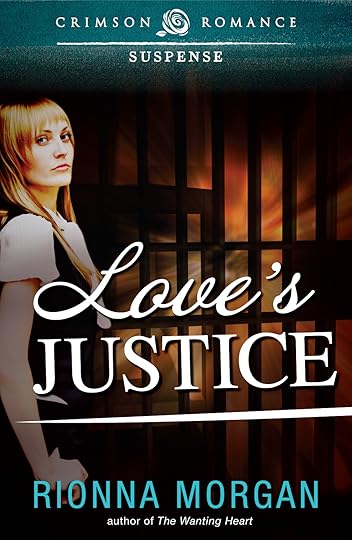 Love’s Justice “A complex and sinister plot leading to a trail of deceit and corruption in a women’s prison in Alabama, a centuries old hotel in Georgia, and a family ranch in Texas. Nothing is simple or as it seems.” Available here http://rionnamorgan.com
Love’s Justice “A complex and sinister plot leading to a trail of deceit and corruption in a women’s prison in Alabama, a centuries old hotel in Georgia, and a family ranch in Texas. Nothing is simple or as it seems.” Available here http://rionnamorgan.com
* * *
Eunice Boeve has lived nearly forever in a small town in Kansas, but the Montana ranch of her childhood still calls to her. She believes her parents, who both died too young, influenced her writing. Eunice writes historical fiction and westerns for both kids and adults. She is a Kansas Notable Author and winner of the Donald J. Coffin Award for her book, Ride A Shadowed Trail.
My dad did not believe in any form of farming. He used to sing the old cowboy lament: “Oh, bury me not on the lone prairie,” with his own added words; “For some dry farmer to plant corn over me.” Dad loved horses and raised them to pack supplies for the US Forest Service to fires, lookouts, and trail crews. The closest he came to farming was raising hay for winter feed for his horses and Mom’s milk cows. He died when we were all quite young. We kept a couple of the horses and with them and Mom’s milk cows still needed some hay. We kids “camped out” in that hay in the barn and jumped off the chicken house roof, which was connected to the barn, into the loose hay.
One year a few weeks before Christmas, Mom’s catalog order containing our gifts arrived and Mom took out our older brother’s gift and had him hide the rest in the barn. I don’t remember ever believing in Santa. We probably couldn’t afford him. But she always gave us each a gift ordered from the catalog. I don’t recall how we knew where our brother hid those gifts. Did we spy on him through a crack in the barn door or did we watch, lying flat on the snow-covered roof of the chicken house? All I know is we dug those gifts up and hid them again on the opposite side of the barn. How we must have giggled awaiting Christmas and likely grinned all over ourselves when big brother came in from the barn on Christmas morning empty handed and totally bewildered. What did I get that year? I don’t remember. Which leaves me to ponder: Is it more fun to deceive than to receive? :-)
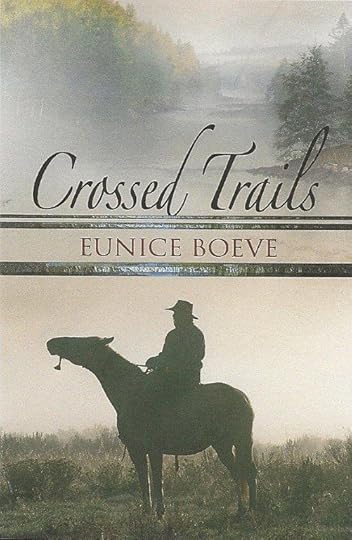 Crossed Trails: The summer of 1877, Joshua Ryder seeking a life of solitude crosses the trail of a Nez Perce woman with a newborn baby and ends up in Virigina City, Montana. There he becomes the provider of an unlikely family and falls under the shadow of the hangman’s noose. Available here
Crossed Trails: The summer of 1877, Joshua Ryder seeking a life of solitude crosses the trail of a Nez Perce woman with a newborn baby and ends up in Virigina City, Montana. There he becomes the provider of an unlikely family and falls under the shadow of the hangman’s noose. Available here
* * *
My thanks to Paty, Karen, Amy, Rionna and Eunice for taking part and, most especially, for agreeing to do the following giveaways with me:
1) One e-copy of my book, Loveland, will be given away to a person who tells me what career Lady Alex is pursuing. The answer can, of course, be found on this web site and must be sent to me via the Comment box on the ‘About the Author’ page. Second prizes for all correct answers.
2) Paty Jager has a published Christmas story. Go to her blog or website; find the title and leave it and your e-mail in the comment section here. She’ll send everyone who comments a goodie plus one name will be drawn for one of her books.
3) Karen Casey Fitzjerrell will randomly select one person to win a copy of The Dividing Season from comments left below.
4) Amy Hale Auker will award one signed copy of Rightful Place along with a bonus gift to one person who can answer the question, what sort of jewelry does she NOT like? Answer may be found on her website and sent to Amy via her contact page at www.amyhaleauker.com or via email to rightfulplace@gmail.com
5) Rionna Morgan is giving away a copy of Love’s Justice—drop on by her blog (rionnamorgan.blogspot.com) to enter by rafflecopter.
6) Eunice Boeve will give away two copies of Crossed Trails to the first two who visit her current blog at http://www.euniceboeve.net ,find the kind of pie her mother used to make and e-mail her the answer at roneun@ruraltel.net along with their name and address.
Winners will be announced here on or about December 20th. Good luck, and Happy Holidays!


November 1, 2012
Curios and the Curious
Back in the late 1970s I was traveling through New Mexico with my parents, die- hard New Yorkers who knew nothing of the west. We happened upon the trading post at Gallup, where my mother started chatting with the lady owner. All I remember from that conversation was the fact that my mother was totally astounded that the woman had never heard of Broadway in NYC. Here was evidence of the singular culture of the west, more isolated then and certainly unique, and it was all around me in that shop. The fact that, here, there was no yearning for The Great White Way as Broadway is occasionally called, but something more positive, more organic, moved me completely.
Then something else happened. My parents bought me a Navajo-made waterfall necklace: seven delicate strands of liquid silver and turquoise to grace my then-youthful neck. I thought it was the most wonderful thing I possessed (and still do possess)—and so a love affair was begun. Native American jewelry.
The curio trade of Native American Arts in the southwest began in the 1880s when anyone with a storefront, from grocers to undertakers, started trading in native goods. Predominantly pottery, weaving and baskets done by women, the curio trade took off when the railroad came in and with the advent of mail order catalogues. Silversmithing was originally brought from Mexico in the 1870s when items were traded for livestock and other goods. But the cost of the materials and the labor required to make one small item proved prohibitive for Native Americans; early pieces were most likely made by smiths of European origin, many from the Canon City, CO penitentiary.
Between 1900 and 1925, the rise in demand for southwest silver jewelry was meteoric. Pueblo (predominantly Zuni and Santo Domingo), Hopi and Navajo men found employment in curio shops where they were trained to do the store’s own designs and used as living exhibitions, sometimes working in the store front window. By the 1930s, silversmiths were trained at the Indian Schools. The silver used was mostly Mexican pesos or other pure silver coins that were hand worked. In the southwest and the Rockies, the demand became almost impossible to meet and so the dealers, who controlled the entire industry, started to bring in mechanization. In the 1930s, the first machines were used as was sheet silver which saved time for the artisan. However, it proved difficult to get a balance between saving time and putting out more products vs. the possibility of unemployment due to overproduction. Enter the United Indian Trader Association. UITA was formed after a bill failed to pass in Congress protecting Indian-made products. They pressured government to prosecute curio shops advertising “Indian Made Jewelry” which was machine made, even if by Native Americans.
In 1941, the Museum of Modern Art in New York had an exhibition, “Indian Arts of the U.S.” thereby giving the curio trade an air of legitimacy above that of being just souvenirs. Hallmarking, which started after WWII and became prevalent by the 1960s, also helped; even today, some shops still give you a certificate of authenticity with a purchase, particularly if it is not signed. Long gone are the prices between $1.50 and $60 for a bracelet—work by certain artists has skyrocketed in price, along with the price of silver, ingots and sheet silver now being used.
Parallel to this, the Fred Harvey Company was expanding, building restaurants and hotels along the line of the Atchison, Topeka and Santa Fe Railway. A man by the name of Herman Schweizer started work with the company aged 16 in 1887, managing a lunch room at Coolidge, NM. There he sold Navajo craftwork. Most of the jewelry he sold was pawn, but Schweizer soon found these items too heavy for tourist taste. He had the turquoise mines in NV cut the stones thinner so that lighter weight bracelets and other items could be made. When Schweizer was eventually appointed Head of the company’s Indian Dept. to supply all their curio shops with goods, a certain style now known as ‘Fred Harvey Jewelry’ was born. (See photo 1)

My Fred Harvey bracelet
Most are truly Native American-made since the company stopped carrying anything machine-made when those items were banned from the national parks. My own bracelet pictured here was purchased in Jackson, WY.
It’s interesting that Schweizer found pawn jewelry disliked by the tourists since pawn these days commands excellent prices. Generally heavier pieces made for the artisan himself, they tend to be wide with much stonework. Last summer in Santa Fe I came upon this piece (photo 2) which I was told ‘might be pawn from the 1950s.’ It goes to show how little some of the shop owners actually know, and how careful one must be. I loved it because of the unusual stone—rather than turquoise, it has sugilite, a purplish mineral first discovered in 1944. Most likely the stone came down from Canada as it is not mined in the U.S. But it was the signature that was the real give-away:

Silver and Sugilite bracelet by Kirk Smith
“Kirk Smith.” A Navajo, Smith lived in Crown Point, NM and won many awards, but his work only started in the 1970s.. His style is singular; he favored heavy bracelets of the old pawn style, with intricate silver work and large stones. Smith passed away in a road rage accident between the time I wrote this piece and posting it. I’m honored to be able to own his work.
On the same trip, my daughter and I were going to see Mesa Verde National Park, more than thirty-five years after my first visit to New Mexico and Colorado. We drove into nearby Cortez, CO spotting an interesting shop on our way to lunch. Over our meal, I told my daughter the story of the Gallup Trading Post, just as I wrote here at the beginning of this piece. We sauntered over to the shop for a look around, greatly impressed at the variety and quality it carried. The couple who ran the shop were very friendly and we chatted with them quite a bit, learning that this was their last summer before retirement. My daughter, Cristal, fell in love with a bracelet (photo 3) and called me over to see it. I, too, fell in love with it and so we argued as to which one of us would buy it. It was signed D. Reeves. We were told the tragic story of David Reeves: a gifted silversmith, his wife had shot him dead believing him to be cheating on her. It was only after his death that she learned that he had been faithful all along.
Cristal and I continued our argument as to who would get the bracelet when the woman asked us to wait a moment. She briefly left the shop and returned with a virtually identical bracelet from her own jewelry case so that we might each have one. It was later as we were paying for these that I learned one more fact which, even as I write it now, makes the hair on the back of my neck stand up.
She was the woman from the Gallup Trading Post.

Our 2 bracelets by David Reeves
***********************************************************************
Further Reading:
Batkin, Jonathon: The Native American Curio Trade in New Mexico, Wheelwright Museum of the American Indian, 2008


October 1, 2012
Billy the Kid and Pat Garrett — The Shadow of Doubt
Paul Colt and I had had a few interesting exchanges in the AmericanWesterns group of Goodreads when I learned he had written a book about the Lincoln County War. I’ve been lucky enough to snag him here to write a bit about one of the protagonists in that episode of New Mexico’s history, William H. Bonney, aka Billy the Kid.
Paul’s creative work in western fiction gives expression, as he notes, to his life- long love of the west; his other life as President and CEO of Prism Clinical Imaging would hardly hint at this love of western culture. Among Paul’s many accomplishments is the fact that he was the founder, designer and director of the nation’s first ATM network. He has designed, developed and launched no less than fifteen information technology products. However, let me tell you that I had to prod this information out of him, and it is my guess that he is equally proud of being a Western Writers of America Spur finalist in 2009 for his book, Grasshoppers in Summer. In addition to this and his two previous novels, his recently completed Boots and Saddles– a Call to Glory, about the early career of George S. Patton, received the Marilyn Brown Novel Award, presented by Utah Valley University for excellence in unpublished work.
Paul and his wife of 42 years, Trish, live in Lake Geneva, WI. They have two grown children and four grandchildren—their very good reason for not moving to Cody, WY. Paul does, however, manage to get western dust on his boots when he researches his stories—whenever possible from the back of a horse. And his choice of his pen name is an obvious nod to his longstanding love of the west.
I’m privileged to have him here to share his theories about the death of Billy the Kid.
The Shadow of Doubt
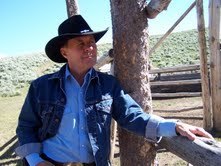
Paul Colt
History: A prismatic lens through which we view the past as seen by those who record it.
With all due respect to serious western historians, I have come to take my historical helpings with that proverbial grain of salt. The power of the printed word may have reached its zenith in the nineteenth century. Recorded history from the period comes down to us with the cachet of fact. But is it always? Pick an historical character or event to research and the next thing you know you’re in the middle of some unresolved controversy. I encountered the phenomenon while researching my first book, Grasshoppers in Summer. A few years and a couple more controversies later I came to the prismatic lens observation. That phenomenon leads to one of my favorite controversies.
Historians agree: Sheriff Pat Garrett killed Billy the Kid, July 14, 1881. Why? Because Pat Garrett and Pete Maxwell said he did. One hundred thirty years later questions remain. John Poe, Garrett’s deputy on the scene that night, and others question Garrett’s claim. They suggest he killed the wrong man and covered it up. Garrett was prompted to write his 1882 book The Authentic Life of Billy the Kid in response to those questions. Enter the power of the printed word. That book comes down to us today as the accepted historical account of the Kid’s death. Is Garrett’s claim proven beyond the shadow of doubt? Or is it a hastily conceived cover up?
Conspiracy theorists got a dose of encouragement in the 1930’s when Brushy Bill Roberts surfaced in Texas, claiming to be Billy the Kid. Historians were vindicated when Robert’s claim was proven a hoax. Still the controversy persists to this day. Why? Because there are contradictions, irregularities and unanswered questions that simply won’t go away.
According to Garrett, he rode out to Fort Sumner accompanied by deputies John Poe and Kip McKinney, acting on a tip the Kid was hiding in the area. They set up a watch for the Kid in an orchard on the edge of town on the night of July 14th. Garrett’s account states that he saw someone resembling the Kid approach Pete Maxwell’s house and followed him. Poe has it that Garrett entered the Maxwell house to question Pete Maxwell before the man they believed to be the Kid arrived. By Poe’s account, Garrett left his deputies on watch outside where they were seen by the man who next entered the house. This is potentially a significant difference in the two stories. As Garrett tells it, the Kid entered Pete Maxwell’s darkened bedroom and, in Spanish, asked Maxwell the identity of the men outside. Garrett claims he recognized the Kid’s voice and shot him.
Poe’s assertion that the victim entered the Maxwell house after Garrett is intriguing for substantive reasons. According to Poe, the victim reached the Maxwell front porch and encountered the two deputies. Put yourself in the Kid’s stockings that night. (The victim wasn’t wearing shoes.) You are a wanted desperado with a death sentence hanging over your head.
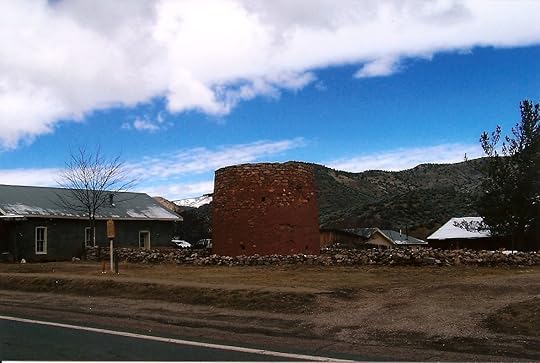
Lincoln, NM:The wall in the foreground is where Billy the Kid and the Regulators ambushed and killed Lincoln County Sheriff William Brady and one of his deputies.
You encounter strangers skulking about your intended destination. Do you go inside to find out who the unknown visitors are or do you scoot back to your hidey-hole? By Garrett’s own account the Kid was too smart to take such a risk. If, by contrast, you are one of the Kid’s many friends in the area, you have no reason to fear the unidentified strangers. If your friend is hiding nearby, your instinct is to warn him of potential danger. You might go inside to find out the identity of the strangers. Then there is the matter of language. Why inquire in Spanish? Maxwell spoke English. The Kid spoke Spanish but it wasn’t his first language. He did have a goodly number of Mexican friends in the area. Someone entered Pete Maxwell’s bedroom that night and very likely died. Was it the Kid as Garrett asserts, or one of his friends?
If the Kid was hiding in the area when the shooting occurred, he probably got word of his ‘death’ pretty quickly. In a ‘Mark Twain moment,’ he could easily have decided that an exaggerated report of his death was better than a pardon. Could he have escaped that night and later assumed some new identity? It seems possible. That, of course, is speculation. Reaching such a conclusion from here would require a good sized leap in logic if it weren’t for the rest of the story.
Following the shooting, Garrett and Maxwell took charge of the body and the events of that night and the next morning. Their actions are tainted by serious irregularities. Maxwell is reported to have written the coroner’s report and the verdict for a coroner’s inquest. The local postmaster signed the inquest verdict as foreman the following morning. The jurors never met as a group. The coroner’s report and inquest verdict were entrusted to Garrett to file at the Lincoln County Courthouse. Neither document has ever been found. A facsimile of what appears to be the inquest verdict was discovered decades later. Misspellings and the use of ‘marks’ witnessed by Pete Maxwell suggest that some of the jurors signatures may have been falsified. Is it possible Garrett ‘lost’ documents he feared wouldn’t stand up to close scrutiny? The body was buried the following morning. It was not publicly displayed as was the custom with high profile outlaws in those days. No photos were taken of the body or Garrett with the body as was also the custom.
These irregularities circumstantially favor the appearance of a cover up. The Kid had a reward on his head. Garrett was not a rich man. Presumably he could have used the money. Under the circumstances you would expect him to take the customary steps to substantiate his claim. He didn’t take those steps, which probably accounts for the long delay in authorizing payment of the reward.
If Garrett killed the wrong man, he had motive enough for a cover up. He also had the notoriety, celebrity and opportunity for reward associated with having killed the most wanted outlaw in the territory. That leads to the question why would Pete Maxwell help him? History tells us that the Kid was romantically involved with Paulita Maxwell, Pete’s younger sister. The relationship is thought to have deepened in the weeks following the Kid’s escape from the Lincoln County jail. Pete Maxwell’s motive for participating in a cover-up might have been to get the Kid out of Paulita’s life once and for all.
There are those who vigorously defend the account of the Kid’s death as told by Garrett in his book. Apart from money, which Garrett denied was his motive in writing the book, the publication seems self-serving in other respects. The power of the pen firmly established his claim on having killed the Kid. In the book, he suggests Poe and McKinney questioned the identity of the victim at the time of the shooting. He then goes on to refute that allegation. According to Poe, he initially supported Garrett’s claim. His doubts and the question of mistaken identity came later. Garrett’s recounting the events in his book more than a year after the fact seems a convenient response to Poe’s suspicion.
Did Pat Garrett kill Billy the Kid? Historians are convinced. They have Pat Garrett’s word on it. The state of New Mexico is convinced. They’ve got an iconic legend and the tourist attractions that go with it. One hundred thirty years later some of us are still troubled by the contradictions, irregularities and unanswered questions. Which leads to the ultimate question; if Garrett didn’t kill the Kid that night, what happened to him? Did he simply ride off into the sunset never to be heard from again? A plausible answer to that question is ‘Maybe he did.’ Like so much of this controversy, that supposition depends on circumstantial evidence and hearsay that came to light years later.
I’ve written a book based on Poe’s account and the loose ends Garrett and Maxwell left behind. I call it A Question of Bounty, The Shadow of Doubt. One of these days I hope to find a publisher for it. When I finished, I concluded that the controversy is one man’s word against that of another. Both cases are circumstantial. Neither case can be proven conclusively. Once again history has opened a window to the past shadowed in doubt.
Paul Colt
*********************************************************************
Paul has very generously offered to give away copies of his book, Case File: Union Pacific, to no less than 5 lucky people who leave a comment. Winners will be announced on 22 October.
When President Ulysses S. Grant suspects a fraud worth millions of dollars involving the transcontinental railroad, he sends Marshal J.R. Chance to Wyoming to investigate. Chance joins forces with a Cheyenne woman who saves his life. Together they confront a ruthless conspiracy that will stop at nothing –including murder– in its quest to monopolize Union Pacific construction contracts and the lucrative land grants that go with them.


August 31, 2012
A Lynching, an Opera, and a Book
The lynching of ‘Cattle Kate’ is a story most people interested in the history of the west know, yet don’t really know. It’s a story that’s gone through so many permutations, from “Cattle Kate” becoming the name of a western wear company through the all-star, disastrous three and a half hour re-writing of history called “Heaven’s Gate,” that most people nowadays would probably just relegate it to the annals of The Wild West. Basically, the tale as it has stood through the years is that on the morning of July 20, 1889, a vigilante party led by one Albert Bothwell accused Ellen Liddy Watson
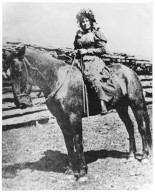
Ellen Liddy Watson, by kind permission of the Wyoming State Archives
and her ‘lover’ James Averell of cattle rustling and branding, and summarily took them out and hung them. Subsequently, Bothwell and his cronies were tried but, being wealthy cattlemen and ranchers, members of the prestigious Wyoming Stockgrowers Association, they were let off. It was left as a shameful episode in the history of Wyoming.
Even as late as 1966, Helen Huntington Smith in her book, The War on Powder River (Univ. of Nebraska Press, Lincoln), was writing from legend rather than fact and calling Watson “ a strumpet with a vocabulary to match.” Huntington Smith was, and is, a respected writer of western lore; her book, We Pointed Them North: the Recollections of E.C. ‘Teddy Blue’ Abbott has gone through numerous printings and is a must-have for any reader of western history. Yet Huntington Smith, while calling the lynching “the most revolting crime in the entire annals of the West,” describes Ella as a “full-bosomed wench” who had “gone west and gone wrong.”
Here is a case of using secondary sources without checking facts. The Cheyenne papers, which Huntington Smith had consulted, were under the thumb of the wealthy ranchers. The stories they had printed regarding this episode were nothing more than yellow journalism at its worst. And the Denver, Chicago and New York papers picked up the sensational stories more or less as written, thereby endowing the account with a prestige and veracity it didn’t deserve. Cheyenne had lifted the soubriquet of ‘Cattle Kate’ from earlier stories regarding a known prostitute who had a reputation as a wild woman who ran a bawdy house and was a known rustler and thief. They pinned the name on Ellen, along with the other woman’s reputation, in order to legitimize the cattle barons’ actions. And that is the way the story stood—until George W. Hufsmith came along.
Hufsmith, who had been born in Nebraska, brought up in Brazil, and gone back to his family’s Wyoming roots to ranch, had studied music and was a part-time composer. He also served for six years in the state’s House of Representatives and was responsible for the formation of both the Wyoming Arts Council and what became the Grand Teton Music Festival in Jackson. To celebrate the country’s Bicentennial, Wyoming commissioned Hufsmith to write its first grand opera—‘The Sweetwater Lynching’—and thereby started Hufsmith on a 15 year journey to uncover the truth about Cattle Kate. The result of his findings became The Wyoming Lynching of Cattle Kate-1889 (High Plains Press, Wyoming).
Hufsmith, who sadly passed away in 2002, did thorough and exhaustive research for fifteen years tracking down records and correspondence and interviewing descendants of the families involved. He discovered that, rather than the hard-bitten cattle rustler and paramour of ‘Cattle Kate’ that legend would have us believe, James Averell was a well-educated former soldier, a postmaster and surveyor and a justice of the peace. Ellen Watson was certainly not a prostitute taking unbranded cattle for her favors, but helped Jim run his store and serve cooked meals. The two were secretly married because the Homestead Act allowed for only one homestead per family. Few couples paid attention to this, and Ella and Jim weren’t an exception; they traveled to Lander to secretly become man and wife, kept it hush, and signed for two homesteads on the Sweetwater. And that led to a problem.
Cattle baron Albert Bothwell had been ranching on the Sweetwater using open range he did not own. When Jim and Ella, combined, applied for homesteads on part of this range, Bothwell lost his water rights. Ella and Jim controlled over a mile of a year-round spring called Horse Creek and, although Jim had sold Bothwell an easement to the Sweetwater, he had also built four miles of irrigation canals. In Wyoming, to this day, water rights mean life or death and cause feuds. Bothwell, an arrogant man full of his own self-importance, was not going to stand for this. And so, on that fateful morning during a round-up, he gathered six of his closest friends, went over to Ella’s homestead and abducted her before continuing on to Averell’s place and forcing him into a wagon. And the couple were lynched.
In Hufsmith’s breezy and, at times, humorous style, he goes on to recount the outlandishness of some of the theories previously put forth. He also shows how witnesses went missing (possibly murdered), how the law was ignored in the case of the six accused, and how history has been hoodwinked by what the press of the day had written. Hufsmith also finishes the story for us: of the six lynch men, four sold up and left Wyoming very soon after being found innocent of the crime. Only Bothwell and his close friend, Tom Sun, stayed on to continue to ranch. In the case of Tom Sun, his family were still there when Hufsmith published the book in 1993. As for Bothwell, he hung on to his ranch on the Sweetwater for twenty-odd years before retiring to California. And then, as legend would have it, he died mad in an institution.
Whatever the truth of the matter, the lynching of Ellen Watson and James Averell proved to be a small battle in a larger war. It was a heinous crime, yes, but it was only the start of what later became the Johnson County War.
**********************************************************************
Nancy Curtis of the esteemed High Plains Press has VERY kindly offered to award one copy of The Wyoming Lynching of Cattle Kate-1889 by George Hufsmith to one lucky reader of this blog who leaves a comment. The winner will be chosen on Sept. 23rd. Or, naturally, you can purchase your won copy here
***********************************************************************
My sincere thanks to the Wyoming State Archives for supplying the above photo, and to Cindy Brown for her help.


August 2, 2012
My Baby Has Arrived
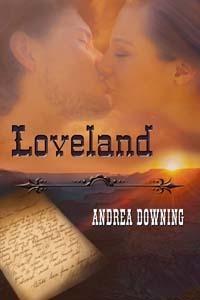 Writing a book is like having a baby–the only real difference is that there is more struggle in the conception of a book. And once the book is handed over to a publisher, a midwife willing to help you bring forth your cherished creation, there are months of editing as the baby moves towards taking its final shape. There are months of waiting as other people do what they must to make sure the baby is healthy, months of trying to get on with your normal life, write the next great opus, and continue to wait while kindly friends and relatives politely ask—this time without patting your stomach—how you’re doing. What they really mean is, what’s taking so long? And long it is: the months pass; you make the preparations for the baby’s arrival. In the case of the book, you blog like hell, get your name out in the social media, build a platform and wait some more.
Writing a book is like having a baby–the only real difference is that there is more struggle in the conception of a book. And once the book is handed over to a publisher, a midwife willing to help you bring forth your cherished creation, there are months of editing as the baby moves towards taking its final shape. There are months of waiting as other people do what they must to make sure the baby is healthy, months of trying to get on with your normal life, write the next great opus, and continue to wait while kindly friends and relatives politely ask—this time without patting your stomach—how you’re doing. What they really mean is, what’s taking so long? And long it is: the months pass; you make the preparations for the baby’s arrival. In the case of the book, you blog like hell, get your name out in the social media, build a platform and wait some more.
And just as every pregnancy is different, every author’s journey is different. Mine started at about age 8—rather too young to have a baby—when I wrote my first ‘novel’ in a school notebook. Years went by, classes were taken in creative writing and English, stories were churned out and manuscripts were written and thrown away or shelved at the back of the closet. I wrote a bit, co-edited a magazine of British and American poetry, taught English in Britain and Nigeria, and somewhere down the line lost my way. This author’s journey came to a complete standstill for a time. Some might call it writer’s block. The baby was caught on the brim…
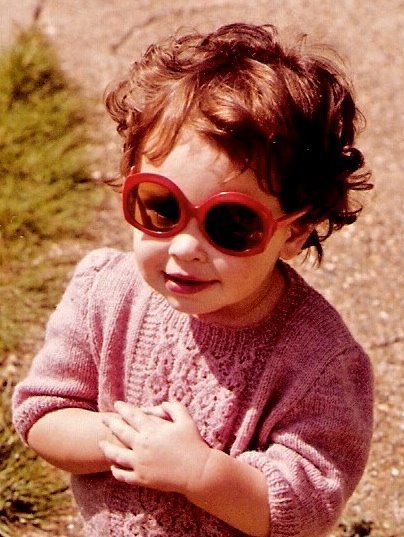
My baby, Cristal (who’s now 28)
When my own daughter was born ‘caught on the brim,’ they were still using a method called ‘high forceps,’ soon to be replaced by a straightforward C-section. Either way, it’s a difficult birth and a pretty good metaphor for what writing and publishing a first novel is like. But the struggle is overcome, the mother recovers, and then family and friends gather once again to coo over the baby and tell you how wonderful you are and how beautiful the baby is. Maybe some of them actually mean it and maybe some of them go away and say amongst themselves that it’s the ugliest baby they’ve ever seen. But it’s your baby and you love it…
Well, my baby has arrived. My western historical romance, Loveland, is now available in paperback, published by The Wild Rose Press; the digital version will be out August 10th. In the case of a book, the ones who think it’s “ugly” will, for the most part, be telling me out loud, if not exactly to my face. If that’s the case, I’ll have to get out my ‘big girl’s panties,’ pour myself a drink and hope that the next ‘baby’ is a little more beautiful. But make no mistake, this one is mine and I stand by it. I love my baby, and I hope a few others do too.
**********************************************************************
To help me celebrate the publication of Loveland, I’m giving away an assortment of prizes, including one copy of the book, to readers who comment before the 14th August. But if you can’t think of anything to say, just answer 5 of the following 7 questions (preferably without resorting to Google!) and leave the answers. Most of the answers can, of course, be found in my book. I’ll post the winner of Loveland on or about the 17th. And please check my “Appearances” page for other places I’ll be blogging and interviewed this month.
1) What is a honda (other than a car of course!)?
2) A ‘cayuse’ is (a) a grumpy young lady (b) part of a saddle or (c) an ornery horse.
3) Appaloosa are associated with what nation?
4) One of my characters says, “Has she sacked him out yet?” To what is he referring?
5) What are leggings more commonly known as?
6) In the Order of Precedence a Duke comes after (a) a Marquess (b) a Prince or (c) an Earl.
7) In addressing a non-royal Duke, one would refer to him as (a) Your Highness (b) Your Eminence or (c) Your Grace.


June 28, 2012
An Interview with Eunice Boeve

Eunice Boeve
Eunice Boeve, a Kansas resident, grew up in Montana and Idaho, influenced by a story-telling cowboy father and a reading, poetry-loving mother. Her first submission for publication—and subsequent rejection—was a poem her sixth grade teacher encouraged her to send to the Weekly Reader. Besides a few short children’s stories and as many articles, she is the author of four middle grade historical novels, an adult historical fiction/western novel, Ride a Shadowed Trail, and its sequel, Crossed Trails, soon to be released by Whiskey Creek Press. Before retiring, she worked as a speech para in a school for special needs children and as a bookkeeper/secretary in her family-owned funeral home. Eunie and I are both members of the organization Women Writing the West and we’ve had a lively correspondence for well over a year now. I’m thrilled to have her with me today.
So Eunie, with two parents who loved stories and reading, what books and authors influenced you?
As a child I grew up with stories about the west and about cowboys, like Will James’ Smoky the Cowhorse, and Zane Grey’s stories, but also the Bobbsey Twins, Heidi, and Little Women. I never liked the Nancy Drew or Hardy Boys stories. Actually, I could fill your whole blog with books I’ve loved and why
You’ve got this new book coming out, a sequel to Ride A Shadowed Trail—what research did you have to do? Did you, for instance, go to Texas?
I did. For Ride a Shadowed Trail I spent some time in Texas in Victoria and along Matagorda Bay. I intended to write about a real woman, named Margaret Borland, who took a herd of cattle to Wichita in 1873. Instead, I wrote a novel about Joshua Ryder from age 8 to 19 who also lived in Texas in the 1870s and who went on a trail drive to Wichita. The research I did on Margaret Borland, I ended up using in Josh’s story. I’ve researched the areas of my other books as well, from West Virginia in A Window to the World to the Sierra Mountains where Virginia Reed of my story Trapped! spent an awful winter. Also researched for Maggie Rose and Sass and for the Summer of the Crow, but did not have to travel far for both settings are in Kansas. My new book, Crossed Trails, to be released in July, took me to Virginia City, MT. I’d been there before, but this time as a setting for my story, I saw it through different eyes.
What made you choose this setting and time period?
Because Crossed Trails is a sequel to Ride a Shadowed Trail, I had to stick to that time, but in Montana rather than Texas. Why Montana? Well I grew up there so that’s probably a part of it, but I think the protagonist Joshua Ryder (Josh) decided it himself. At the end of Ride a Shadowed Trail, feeling footloose and with no definite plan in mind, he thinks he’ll hire on with a cattle drive headed for Montana in the spring.
Was the idea for this second book in your mind when you wrote the first or did it come to you later?
Actually, when I finished Ride a Shadowed Trail, I had no idea I’d carry Josh on into another story. But my readers kept hassling me about it with various questions all in the form of “so what happened next.” Finally, I decided to see what happened next and the result is Crossed Trails.
We’ve mentioned your parents and their love of stories and reading—but how did your upbringing influence your writing?
In several ways, including the time and place where I was raised, where the old west was/is still revered and the influence of a father who was the last of those old time cowboys who hated sheep, farming, fences, and the encroachment of so called civilization. Two other factors that influence my writing are, first my dad’s death when I was five which tore a very large hole in our family, a hole never really mended, and secondly because Dad wrote a book about his cowboy days in Wyoming and a horse that was special to him. He died shortly afterwards so the manuscript was never published and was lost some years later. (My stories often have a missing or deceased father as if I’m still trying to come to terms with that loss)
Your character/hero is not the usual romanticized hero–Joshua has a slightly ‘unsavory’ background perhaps. Was this a problem in writing or did you specifically set out to make him more complex?
My characters seem to be who they are. I have no designs on them, they come into a place and grow from there. As in Ride a Shadowed Trail, Josh shows up as an 8-year-old boy who’s father was white, his mother, Mexican. His mother, who earns their living by prostitution, is murdered, and I did know why, so I went back and wrote a couple of chapters introducing her and her story. And then I flashed forward to Josh the night his mother is killed. My three daughters are my first readers and one of them said, “Mom, you don’t need those first three chapters, just get rid of them.” Her sisters agreed and so I did. The mother’s life is never fully explained as the story moves on, but enough so that the reader understands the “what and why and wherefore” of her being in Texas and specifically in Indianola.
You also write YA and children’s stories: is there a big difference in your style, story or character development for the 2, or even for research?
Obviously one doesn’t use adult themes or cuss words. Otherwise, I don’t think so.
In your stories, as in Ride a Shadowed Trail, someone dies, someone whose death seems out of line or even cruel and heartless on your part. Was it a difficult decision and have you had readers give you any flack about it?
First of all, both times it happened—the other time was in my book Summer of the Crow—it’s unexpected and I’m crying as I’m typing those words and usually I have to quit writing for a while. I actually mourn the loss of that character whom I’d grown to know, who seemed to live and breathe in my mind. I am also sad for the other characters who will grieve their loss. Sure, I could have snatched them from the jaws of death, but to be true to the story that is unfolding as I go, I’d then have thrown the proverbial “monkey wrench” into the works. In other words I’d have taken control and the story would no longer be theirs but mine and I’d not be surprised if the whole thing would grind to a halt.
Would you say your writing is plot driven or character driven? Do you find your characters suddenly do things you hadn’t expected?
Definitely character driven. They tell the story, not the other way around, so yes, often I’m surprised. The other day a woman asked me how I plot a story. I told her I don’t do plots. The plot/theme develops as the story unfolds.
So what’s next? You know I’d like you to write a memoir, any chance of that?
I’m not sure. The last two years I’ve done a kids’ serial story for a group of Kansas newspapers for a program called Newspapers in Education and am scheduled to do another one, so I’ll start on that in the fall. Of the other two serials, I added ten more chapters to the first one, a time travel story and it’s in the process of being published. Now I need to write ten more chapters for the last one, a WWII story and work on getting it published. Plus I now have three out of print books I need to do something with. But for another western, I’m looking at a little half Chinese, half white girl in Crossed Trails and wondering what she’ll be like when she’s grown up.
A memoir? Well, I just finished writing a short one about when I was five-years-old. What I’ll do with it, if anything, remains to be seen.
Well, thanks so much for stopping by, Eunie. I’ve really enjoyed our visit. Let’s just remind folks that Crossed Trails will be out this month from Whiskey Creek Press. You can purchase this at http://www.whiskeycreekpress.com/store/ For more info on Eunice, please take time to visit her website at http://www.euniceboeve.net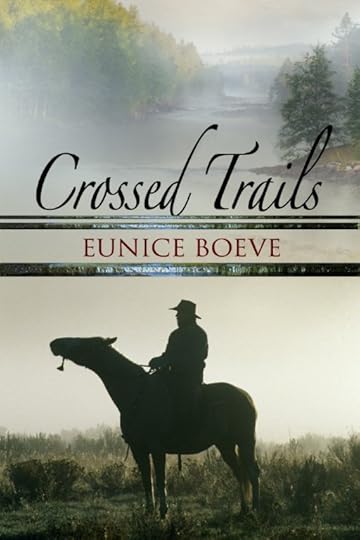 [image error]
[image error]


June 5, 2012
Little England in Iowa: The Close Colony
While researching the background for my historical western romance, Loveland, I came upon some interesting stories of the British aristocracy in America in the late 1800s. One that captured my imagination is the story of the Close Colony, a settlement in northwest Iowa around the LeMars area. This was projected as being for British gentlemen farmers who might live as landed gentry in the American mid-west. While the thought of British aristocrats living in Iowa may seem a bit incongruous to our contemporary sense of place, coming to unplowed soil on the American prairie, and owning huge tracts of land as gentlemen farmers, was not so unappealing to the second sons of noblemen who would not be inheriting their father’s wealth.
William Close,
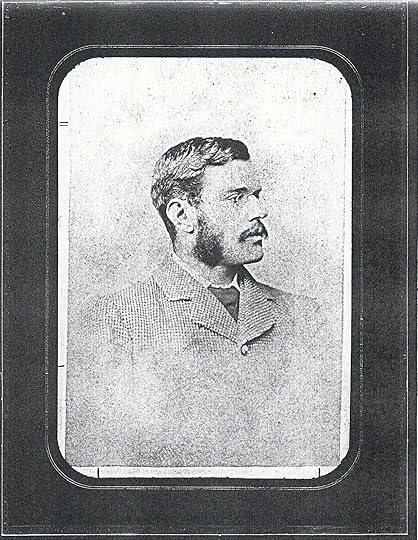
William Close
one of four brothers, instigated the idea of the Colony. A renowned Cambridge oarsmen, in 1876 William was over in Pennsylvania for a regatta when an injury took him out of the race. During his convalescence, Close had a chance encounter with an Illinois businessman, Daniel Paullin, who had made his money by buying farm land while still cheap, and selling it on at increased prices once turned. This fortuitous meeting was followed by a visit to William’s brother Fred, who was then farming in West Virginia. Fred had declined attending Cambridge in favor of training with a farmer in Scotland before heading to the states to try his luck.
In the 1870s, the area with the most promise for land speculation was northern Iowa. Despite tornadoes, grasshopper plagues and occasional ongoing problems with Native Americans, the fertile untilled prairie could offer great gains to investors. The railroads had been granted as much as 20 miles of land either side of their tracks and were selling it off cheap. The two Close brothers decided, therefore, to try their hand at farming in Iowa, buying well over 2000 acres near Denison. The first year they made a profit of over 54% which, when compared to the typical British farm making just 2 or 3%, was quite spectacular. But William, unlike Fred, was not keen on the physical side of farming and thought again of Paullin’s idea of buying the land cheaply and selling it on. Then, a further idea presented itself: why not combine the two? Why not entice young British gentlemen of means to come and train to be farmers prior to selling them the land? And so, in 1879, the Close Colony was born.
Close Brothers Ltd. with offices in London and Iowa included two further brothers: James, recently returned from West Africa, and, to a less extent, John, the eldest. Locating in LeMars, the brothers were able to buy a huge amount of land at just $2.40 an acre. Considering that those acres would be selling for $35-$40 in just a few short years, one can understand that this became the basis of the Close fortune. However, in addition to selling land, the brothers advertised and arranged for young men of good family to come and be placed with Iowa farmers to learn to farm. There was a charge for this, a higher charge for being placed directly on one of the Close’s own farms, and later, of course, the cost of the land or, at the very least, commissions to Close Bros. for obtaining the land.
Farming in Iowa would be far superior to that of Britain, where several years of bad weather combined with low returns made it an unprofitable prospect. A brochure was therefore prepared and spoke of combining Iowa farming with British society. Taverns in LeMars had English names such as the House of Lords or Windsor Castle, a Prairie Club for gentlemen was arranged, and sports such as lawn tennis, rugby and cricket, then peculiar to the British, flourished. The first golf course in Iowa was due to the colony, polo was played
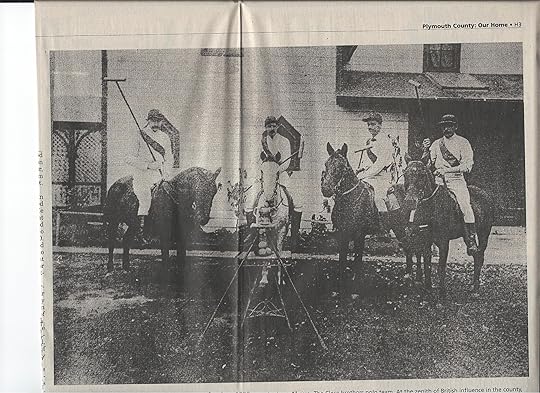
Polo team
—another first—and croquet was a regular pastime. Derby Day became a highlight of the social calendar just as it was back in Britain. St. George’s Episcopal Church was where the English worshipped and gave prayers for Queen Victoria. And hunting went well beyond putting food on the table.
The pupils, or “pups” as they were called, had mixed reactions to their new way of life. For the most part university-educated men, sleeping two to a bed as pups, carting manure or laboring in the fields did not come easily to them.
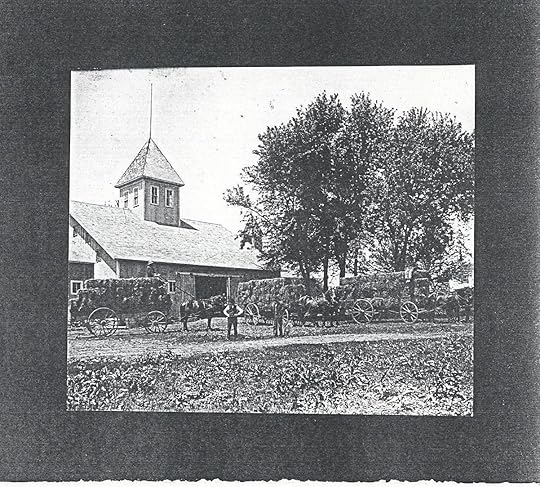
Moreton Ranch, where several pups were housed
One young man described having to sweep up five quarts of flies from his residence despite screened windows. The wild extremes of weather in Iowa bewildered them, and the lack of female company more than annoyed them. At the same time, local Americans saw their locale as being slowly changed into an imitation of Little England, and were appalled at the apparent ignorance of the pups. Obviously, in this atmosphere, jokes were constantly played on the newcomers including one instance where a pup was sent on an errand riding a western saddle. Only thing was, the western saddle with its horn, which the young man had never seen, was on backwards and the pup got rather a pounding in the butt.
The Close Brothers tried to solve the shortage of women by approaching The Women’s Emigration Society, founded 1880, to help with the situation. Sent out as Ladies’ Companions or Lady-Helps, these young women of good birth knew that the life of a servant in someone else’s home would not last long. The Colonial Training Home offered a crash course in domestic duties since these young ladies had been brought up with their own servants and knew little of running a household. Placement was generally through clergymen and always into homes where another woman was already present. In a way, the liaisons between these British women and others that arrived, such as sisters of the pups, actually stopped assimilation between the Brits and America. In the end, the British who remained in Iowa were mostly those who had married Americans.
The Close Colony did not disappear or shut down overnight. And it certainly made a great fortune for its founders who by 1890 were moving away from the farming side of business and into banking and investments, despite having spread their land-holdings into Sibley, Iowa and Minnesota. They had long ago withdrawn from sponsoring the pup plan, mainly due to the fact that word of mouth between pups and friends at home served as better propaganda for newcomers. However, few of these men had envisaged staying on in Iowa; most had seen it as a way of making good money, starting a farm and selling it on in a few years at a profit. Farm laborers were difficult to come by because anyone who came over as such could soon afford to homestead his own land. Furthermore, there was no ‘native population’ as in Africa or India to employ. In addition, a number of events combined to begin the demise of the colony. The first was the death of Fred Close in a polo accident in 1890.

Fred Close 1890, shortly before his death
Fred had been the most ‘hands-on’ of the brothers in Iowa. 1890 was also the start of a terrible economic depression that peaked in 1893 and caused land values to drop significantly while making agriculture unprofitable. By 1895 when the Prairie Club caught fire and had to be rebuilt, the new club was forced to take Americans as well as British members.
Certain remains of the Close Colony can be seen today, most notably the St. George’s Episcopal Church which has been designated a National Historic Landmark.
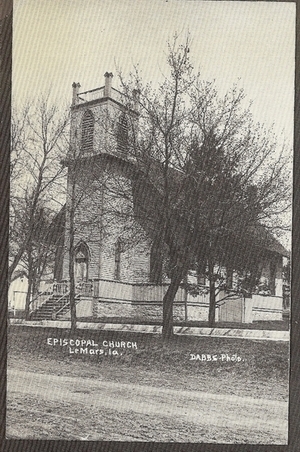
St. George’s Church
**********************************************************************
Photos all courtesy of the Northwest Iowa Genealogical Society.
My special thanks to Betty Winterringer and Mary Holub of the Northwest Iowa Genealogical Society for their help with research, and to Becky Plunkett and Mary Bennett of the Iowa State Historical Society for setting me in the right direction.
Sources and Further Reading:
Harnack, Curtis, Gentlemen on the Prairie, University of Iowa Press, 1985.
Woods, Lawrence M., British Gentlemen in the Wild West, The Free Press, 1989.


May 14, 2012
Texas Sunday Houses by Karen Casey Fitzjerrell
I have as my guest today Karen Casey Fitzjerrell. 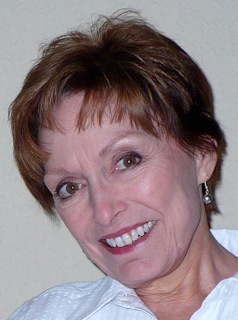 A Texas girl through and through, Karen was born near Houston in Baytown, near the tip of the Houston Ship Channel, and now lives in San Antonio. Formerly a freelance writer for several newspapers and regional magazines in the state, she recently turned to getting her fiction works out from under the bed and into the public eye for us all to enjoy. As a fellow member of Women Writing the West, she very kindly answered my plea for help on all things Texan, serving as background consultant to my own WIP. I’m indebted to her not only for that, but for feeding my fascination with the Sunday Houses I spotted in Hill Country. Over to Karen:
A Texas girl through and through, Karen was born near Houston in Baytown, near the tip of the Houston Ship Channel, and now lives in San Antonio. Formerly a freelance writer for several newspapers and regional magazines in the state, she recently turned to getting her fiction works out from under the bed and into the public eye for us all to enjoy. As a fellow member of Women Writing the West, she very kindly answered my plea for help on all things Texan, serving as background consultant to my own WIP. I’m indebted to her not only for that, but for feeding my fascination with the Sunday Houses I spotted in Hill Country. Over to Karen:
In The Dividing Season, my book set in 1910 West Texas, a woman rancher makes a surprising discovery in a Sunday House
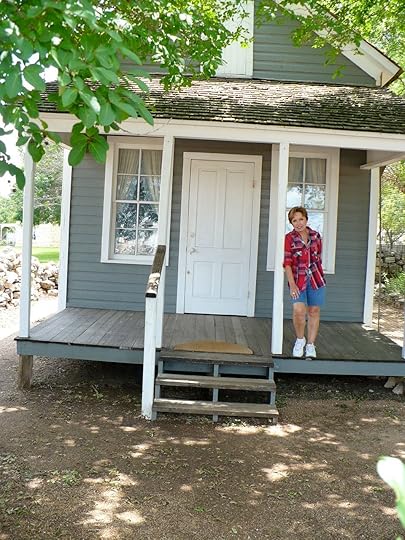
Karen in front of the Weber House which served as her inspiration
that had been built by her grandfather in the late 1800s. The woman recalls many stories exchanged and rehashed between her father and his brother about the wild times they’d enjoyed in the Sunday House when they were young men. Stories of cheating poker games, plots to catch cattle rustlers and cattle buying contracts gone bad.
Until the book’s editor suggested that I explain what a Sunday House was, I hadn’t realized that few people are aware of the houses’ significance to German settlers who ranched and farmed the remote hills and prairies of Texas.
Think about it. Back in those early settlement days there were no Holiday Inns, Marriotts, or LaQuintas on every corner of town. When ranchers and farmers had business to conduct in town he—and as often as not she—rarely had time to finish his or her list of errands before having to head back home before full darkness. It became a common thing for settlers to build very small “houses,”

Sunday house
usually one room, ten feet by ten feet to twelve feet by fourteen feet, on small town lots for the convenience of having a place to stay overnight. Most of the houses had lofts tucked up under cedar or cypress roofs where children slept on cots. The lower floor had a curtained off area where adults slept. A “kitchen corner” with a small table and wash basin were about as elaborate as the tiny houses got.
Whole families would ride a wagon or buggy into town on Saturday mornings (a half day’s ride for most) and visit the dry goods store, hardware store, and bank. Then they’d stay overnight in their Sunday House and attend church services the next morning. Most carried along picnic baskets, and after church services they ate, napped, attended baseball games or visited relatives before the return trip home.
Time spent in town to buy supplies, attend church services and visit was often the only social activity families enjoyed after long weeks of isolation on remote ranches. In New Braunfels, Castorville and Fredericksburg, Sunday Houses were being built as late as 1909. When I researched Sunday Houses online for this blog post I’d hoped to find new insight as to why Sunday Houses seem particular to Texas. I’ve not run across any mention of them elsewhere in the U.S. with the exception of similar “houses” in 1660s Middlebury, Connecticut and in the Pennsylvania Dutch Country. I can only assume that the vast open, empty reaches of Texas necessitated the need for such a convenience.
The custom of Sunday Houses slowly died out with the introduction of motorized vehicles and better roads. Many of the houses still stand to this day and have been renovated as museums, tidbit tributes to a time gone by. Some have been modernized and are rented as Bed and Breakfast getaways.
While researching Sunday Houses for The Dividing Season I thought of the irony that today I reverse the pioneers’ Sunday House habit. I’m a city bound soul who always looks forward to a day trip down dusty roads leading into the heart of Texas. This is especially true in spring when wildflowers turn the roadways into brilliant paths of color. The trouble is – I’ve no Sunday House “out there” and so must return to the choke of city life before my hunger for empty stretches of land and sky is sated. I wonder what The Dividing Season’s cattlewoman would have said about my predicament.
turn the roadways into brilliant paths of color. The trouble is – I’ve no Sunday House “out there” and so must return to the choke of city life before my hunger for empty stretches of land and sky is sated. I wonder what The Dividing Season’s cattlewoman would have said about my predicament.
***********************************************************************
Thanks so much for visiting, Karen!
To find out more about The Dividing Season visit Karen’s website at: www.karencasyfitzjerrell.com
I’ve reviewed The Dividing Season on both Amazon and Goodreads, and here’s a bit of what I said:
“:…Fitzjerrell’s style is restrained yet poetic, capturing the atmosphere of the scenes she describes as well as their physical presence. Her characters come to life with those small, intimate details only a practiced eye detects, the minutiae and small gestures that embody the individual. Her keen observation breathes life into the everyday rituals of a time long gone and makes the reader yearn for a past he never knew. Such involvement with the book is well rewarded, although that is not to say that the story is predictable. While Fitzjerrell keeps a tight rein on her prose, the pages are kept turning until the very end.”


May 1, 2012
OLD NEWS… IS GREAT NEWS! Really? My ancestors did that?
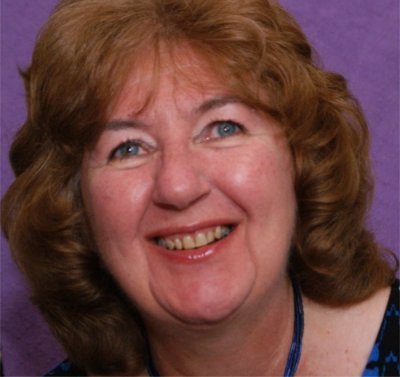
Aauthor Nancy Jardine
I’m very pleased to have visiting here Nancy Jardine, a fellow author at The Wild Rose Press. Nancy lives in Aberdeenshire, Scotland, where she taught 11-12year olds for many years but now writes full-time. Aside from her romantic fiction, she has completed the first in a series of YA time travel books and is currently working on a family saga. As you’ll no doubt gather, this has entailed a bit of sleuthing into her family tree. Welcome, Nancy!
I’m delighted to be with you, Andrea, and thank you very much for this opportunity. I’d like to share with your readers how history, and ancestry in particular, can influence plots in contemporary novels.
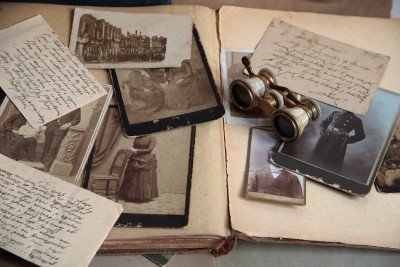 Hold on! Was that word contemporary? Wouldn’t ferreting out historical details regarding family trees be more appropriate to constructing a historical novel…or a family saga? The answer is a resounding yes, but I’ve found that historical and ancestry research can also be deftly employed in contemporary history mysteries. It can be more versatile than might, at first, be imagined!
Hold on! Was that word contemporary? Wouldn’t ferreting out historical details regarding family trees be more appropriate to constructing a historical novel…or a family saga? The answer is a resounding yes, but I’ve found that historical and ancestry research can also be deftly employed in contemporary history mysteries. It can be more versatile than might, at first, be imagined!
My debut romance novel, MONOGAMY TWIST (published Aug 2011), required me to draw up a fictitious family tree, the plot having evolved while I was engaged in ancestry research, and simultaneously re-reading the work of Charles Dickens. MONOGAMY TWIST took shape as my own light-hearted version of a Dickensian bequest, with weird conditions. Luke Salieri is principal beneficiary in the will of a woman he’s never heard of. To inherit the substantial English estate Luke must reside in the property, for one year, with a spouse he doesn’t have. He needs a woman immediately! Rhia Ashton’s the perfect answer: a professional ancestry consultant, she’s unmarried…and gorgeous. Rhia gradually uncovers the mystery name of his benefactor; catalogues the house contents; and helps with the restoration of the old house. How convenient for Luke! Fierce initial desire blossoms into love over the year…though the path takes many twists and turns!
So what spurred that premise for a contemporary novel? In August 2010 I got some startling news-I’ve a cousin, living in Canada, that I’d never known about! My family is in no way unique since war, and emigration, added greatly to estrangement among British families during the 19th and early 20th centuries. On hearing the news I launched in, joined an on-line ancestry program, and now have huge binders of printed details to back up the on-line information. Some of those initial research skills were used to plan MONOGAMY TWIST during late 2010. I enjoyed weaving the twists and turns of that first history mystery so much that I wrote a second contemporary history mystery with a more complicated plot. TOPAZ EYES (currently seeking a publisher) required the creation of a complex family tree-the novel centering on a world-wide search for a fabulous missing jewellery collection. Distant relatives, all unknown to each other before the quest starts are brought together to uncover the jewels. Danger, death and intrigue make the quest a perilous search-yet love blossoms between two of the protagonists (not blood related). Another theme of the novel is the family bonding, and loyalty, that is created along the way.
Ancestry research brings to light such exciting anomalies! Some of what I’ve uncovered is downright sad; some amusing; and lots of it would have been hidden behind locked cupboard doors as late as a generation ago. I believe nowadays, though, with such fantastic internet access that nothing will remain a secret for long (some people might call this an intrusion of privacy). So far in my ancestry researches I’m glad I haven’t found a murderer- that wouldn’t fit my current writing plans-but who knows? If I turn up one of those I might have to get into penning the heaviest suspense genre instead of mysteries!
All those pieces of ‘well that’s amazing’ research have given me fodder for ‘what if’…stories. Have a try yourself and see how quickly you may find plenty of intriguing details to get you started on a family saga, or a historical novel. The handling of real documentation, and accurate historical data, can afford you the freedom to dream and write a fictionalized piece of writing.
How might ancestry research help unlock the imagination of a writer who might be temporarily out of ideas? Getting a multitude of accurate, down and dirty, details from many sources is now much easier: internet access to records fantastic. Back up with general and social historical facts of the era gives plenty of scope for writing fiction.
 Sometimes researching records is easy. At others it leads to a frustrating pile of loose ends-with many unexplained connections, and details that don’t seem to fit. My homeland, Scotland, initiated a compulsory recording of births, deaths and marriages in 1855/ revised 1856. Those records include names, and occupations, of mother and father. From an occupation you can worm out details of likeliest workplaces. Perhaps even how the parents met? Coupled with Census data, that can lead you to find out how permanent, or transitory, the work was more than a century ago. For instance, being a hand-loom weaver in north-east Scotland, during the 1840s, could be a precarious occupation. The vagaries caused by supply and demand often resulted in a hasty removal to find new work, and a new place to reside, the whole family uprooted at regular intervals. Finding answers to a scenario like that might lead to a bit of research on the most likely-and plausible-locations to use in a novel. Inaccurate, or anachronistic detail, is not recommended in historical writing-someone is bound to notice!
Sometimes researching records is easy. At others it leads to a frustrating pile of loose ends-with many unexplained connections, and details that don’t seem to fit. My homeland, Scotland, initiated a compulsory recording of births, deaths and marriages in 1855/ revised 1856. Those records include names, and occupations, of mother and father. From an occupation you can worm out details of likeliest workplaces. Perhaps even how the parents met? Coupled with Census data, that can lead you to find out how permanent, or transitory, the work was more than a century ago. For instance, being a hand-loom weaver in north-east Scotland, during the 1840s, could be a precarious occupation. The vagaries caused by supply and demand often resulted in a hasty removal to find new work, and a new place to reside, the whole family uprooted at regular intervals. Finding answers to a scenario like that might lead to a bit of research on the most likely-and plausible-locations to use in a novel. Inaccurate, or anachronistic detail, is not recommended in historical writing-someone is bound to notice!
Scottish marriage certificates, post 1856, I’ve found even more useful. Names; ages and occupations of the marriage couple; and their addresses before marriage, means you can improvise/ invent how, and where, they met. Given names for all four parents-and their occupations-sets home backgrounds. Which church the marriage banns were read from? How important can that be to the novelist? It can avoid inaccurate details depending on the locations involved…and can allow the author flexibility to home in on the church practices of the time. How large a church? How small a meeting hall?
Names, and addresses, for the two witnesses give scope for developing friendships in your novel, perhaps even setting up secondary characters to lead on to a series of novels. Get the research books out and pad out the daily lifestyle, the poverty of the era…or alternatively the richness of the employers. Poor versus rich has a definite place in the historical novel, or saga, it being a huge factor in the lives of the protagonists. Gleaning all those details from one marriage document can be fabulous information to get you started. That history mystery, historical, or whole family saga is laid before you…
For a future novel (already in my queue as a result of an ancestor who emigrated to the New World) I can envisage my need to investigate records available in America, Canada, and perhaps Australia for sibling information. What might I find there that I can use in future novels? I don’t know, yet, but I hope the research will furnish me with lots of ideas. The keen genealogist will not be thwarted by limited records anywhere…they will ferret out other sources!
Before that? I’ve got to get my already started family saga out of the way first!
I wish you all happy sleuthing (aka ancestry research) and happy writing… Slainthe!
Nancy
Thanks for visiting, Nancy–and thanks for the offer of those gift cards and gift tags depicting Scottish Castles, for one lucky person who leaves a comment. Nancy will make her selection on May 12th and I’ll announce it here.
***********************************************************************
Monogamy Twist- by Nancy Jardine
Luke Salieri thought he’d seen everything. But when he inherits a dilapidated English estate from a woman he’s never heard of—and with quirky conditions besides—it’s a mystery he wants resolved immediately. There must be a woman out there who can meet his needs. But how far will he have to go to persuade her? Lucrative employment for a whole year? The job of researching the old house and its fantastic contents is enticing – but Rhia Ashton can’t see herself living with gorgeous Luke Salieri and not wanting his body as well. Can she live and sleep with him for a whole year and then walk away? Rhia has her own ideas about what will make it worth her while.
MONOGAMY TWIST is available from:
The Wild Rose Press : http://bit.ly/wOpGbT
Amazon.co.uk: http://amzn.to/ynu0t0 Amazon.com: http://amzn.to/wwaGCv Barnes and Noble: http://bit.ly/AuMbii
Link to YouTube Book Trailer for Monogamy Twist is: http://www.youtube.com/watch?v=mJVzbrkJQzA
Website: http://nancyjardineauthor.weebly.com
Blog: http://nancyjardine.blogspot.com


March 29, 2012
Pearl of the Prairies: The Cheyenne Club
Sometime in my youth, The Cheyenne Club entered my consciousness via my viewing diet of western television programs . It was therefore no surprise that this bastion of privilege and luxury, and sometime-home to the British ranchers who had invaded Wyoming, would make an appearance in my western historical novel which deals with the very large ranches run by aristocratic Brits.
In the 1880s, Cheyenne, Wyoming, was reputedly the wealthiest city on earth on a per capita basis. Conveniently located on the transcontinental railroad system, it proved an ideal spot to establish a gentleman’s club catering not only to the British aristocrats that were now there, but also to the cattle barons, railroad magnates, industrial giants and political movers and shakers within its reach. Set up to rival the Corkscrew Club in Denver, which admitted only foreign noblemen, the Cheyenne Club was originally called The Cactus Club, but the name was soon changed. It was built in 1880 with specifications that would rival any London club. 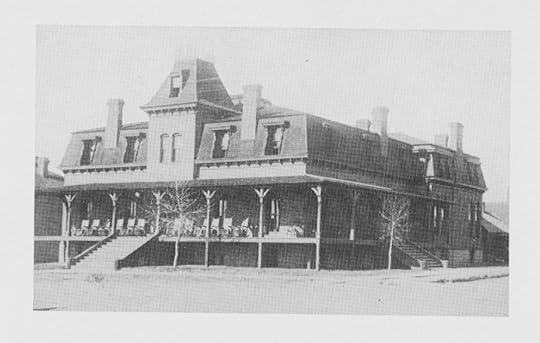 There were two grand staircases, tennis courts, wine vaults, a grand piano, reading, billiard, dining and smoking rooms. Rooms were paneled throughout with hardwood floors overlaid with Turkish carpets, and had tiled fireplaces displaying Shakespeare quotations. Its six bedrooms were completed with walnut dressers and presses, marble-topped commodes and beds of hand-carved walnut. And the library table provided members with copies of Atlantic Monthly, Harper’s and the New York and Boston newspapers, as well as The Drover’s Journal so that they could keep abreast of the Chicago beef prices. Needless to say, the club also boasted a telephone, Cheyenne #76.
There were two grand staircases, tennis courts, wine vaults, a grand piano, reading, billiard, dining and smoking rooms. Rooms were paneled throughout with hardwood floors overlaid with Turkish carpets, and had tiled fireplaces displaying Shakespeare quotations. Its six bedrooms were completed with walnut dressers and presses, marble-topped commodes and beds of hand-carved walnut. And the library table provided members with copies of Atlantic Monthly, Harper’s and the New York and Boston newspapers, as well as The Drover’s Journal so that they could keep abreast of the Chicago beef prices. Needless to say, the club also boasted a telephone, Cheyenne #76.
Limited to 200 members, the Board of Governors appointed a 3 -man committee to oversee its by-laws, which expected, of course, gentlemanly behavior. The rules were designed to keep this haven a small corner of civilization in an otherwise untamed territory. Wagers of any kind were prohibited (though it is said some high stakes games went on in the private rooms), and there were no games whatsoever on Sunday. Smoking was not permitted until after 7.30pm in the dining room, and pipe smoking was completely prohibited. “Loud” and ”boisterous” noise was also prohibited; cheating, drunkenness and profanity were grounds for expulsion. “Any act so dishonorable in social life as to unfit the guilty person for the society of gentlemen” was proscribed. But there was, at times, no rhyme or reason to the punishments dealt out—often, perhaps, dependent on the friendships within the committee. When one member put a shot through an oil painting of a pastoral scene, saying this painting of two bulls was a travesty on purebred stock, he was suspended for three months (the painting now hangs, complete with bullet hole apparently, in the Wyoming State Museum.) When another member—so wealthy as to afford a $4,ooo ‘drag’, the equivalent of a modern day stretch limo– spoke up on the suspension of his brother for striking a waiter, he was censured for his language.
The club suffered a fire in 1882, sending half-naked residents out onto the street, and thereby proving a handy excuse to expand the premises. At a cost of $10K, the new addition included a larger, more elegant dining room, decorated with Japanese papers, a servants’ dining room, and a completely new kitchen with 3 dumb waiters & refrigerator for meats, plus trunk room and laundry. There were now 14 bedrooms, new bathrooms, a post office for the convenience of members and electric lighting. No wonder the great and the good passing through were delighted to be guests; these included Andrew Carnegie, Oscar Wilde, and Owen Wister, who called the club, “the Pearl of the Prairies.” The Wyoming Stock Growers Association had gatherings in the club, as did the legislative council, and the Board of Trade had its headquarters here. Some say that more laws and decisions were made here affecting Wyoming than anywhere else, and it is even rumored that the Johnson County War was planned here. Furthermore, many of the cattle barons preferred living at the club rather than on their ranches, and why not? With lunch at 25¢ and dinner at 75¢, and plentiful Havana cigars, most likely the club was better than home. Food was of the highest order with oysters, fruits, and fresh vegetables brought in, olives, cheeses, and chocolates, not to mention fine wines and liquors and endless champagne.
Such profligacy was not to last. After the disastrous winter of 1886-87, many of the cattle barons were gone, their ranches virtually disappeared. Never great landowners since most of them had depended on open range, the money was gone. This citadel of comfort and exclusivity in a vast wilderness was unable to repay its debts and closed its doors. It was temporarily re-organized as the Club of Cheyenne with a much larger membership, and this evolved into the Industrial Club, forerunner of the town’s Chamber of Commerce. In 1936 the building was razed to make room for a new home for that organization.
***********************************************************************
My thanks to the American Heritage Center, University of Wyoming, for providing the above photo.
Further reading:
Spring, Agnes Wright: The Cheyenne Club, Mecca of the Aristocrats of the Old-Time Cattle Range, Don Ornduff, 1961






